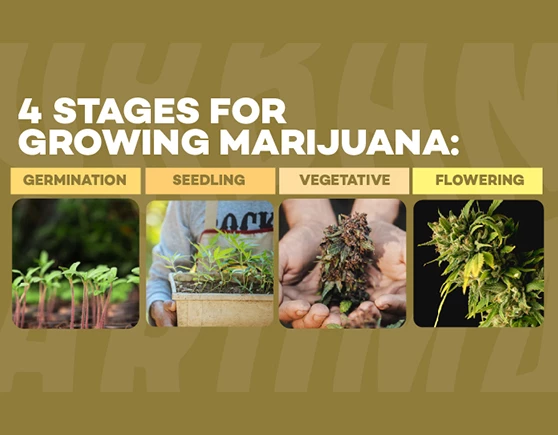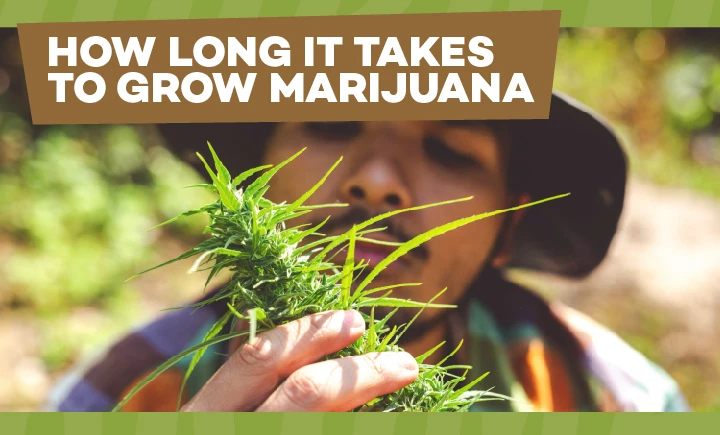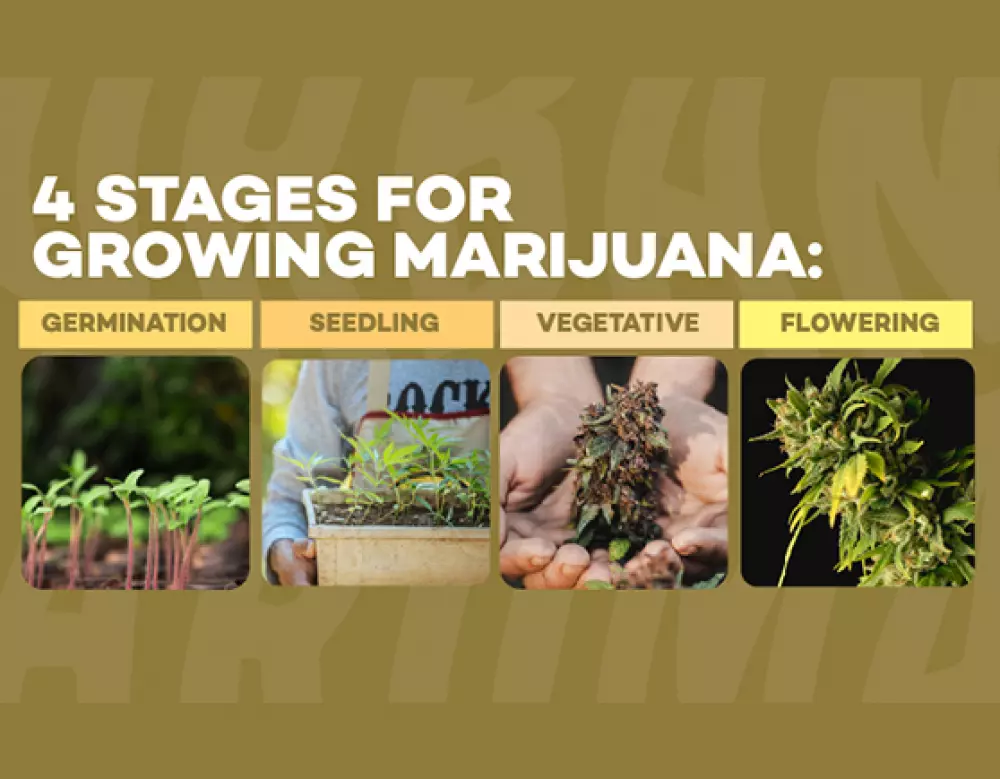Marijuana Grow Stages: A Deep Dive
If you’re considering cultivating your own cannabis, listen up: The most important thing you can do to maximize your yields and your investment is to master the marijuana grow stages. Like all plants, farming cannabis is a process that can offer big rewards — or big busts.
While nothing beats hands-on education, the first step for many new growers is a straightforward rundown of the four main grow stages of marijuana. You must know your plant from seed to flower so you know how to light, how to feed, and when to harvest it.
Each marijuana plant grow stage demands a different kind of care. If you think you’re going to have success with a “set it and forget it” approach, you may be better off with a trip to the dispensary. Growing cannabis, whether it’s for recreational or medical purposes, takes significant planning, oversight, and care.
Understanding the big picture of the life cycle also helps you to identify when the plant is reaching the next phase. This way, you can be ready for your next stages of marijuana growth, get the harvest you’ve been anticipating, and enjoy the smoke you deserve.

The 4 Marijuana Grow Stages
Horticulturalists break up the life cycle of cannabis into four distinct parts. When you are just beginning your growth, it’s a good idea to keep a journal of the life cycle of whatever strain you are cultivating. Each strain will have a different timeline, and other factors like climate and weather may also change the duration of a stage.
Track all variables, including the nutrients you use, the photo-periods, the humidity, and the total yield. From season to season, you will be able to adjust your protocols to refine your techniques as you find reliable patterns.
Farming often involves a lot of experimentation and applied knowledge. The more experience you have with each marijuana plant grow stage, the more successful you’ll be in the next season. Here is a closer look at the marijuana grow stages and how to tell when you’ve reached each one.
Germination Stage
The process of germination is when a seed shoots a single root, called a radicle, downward into the soil. At the same time, a stem will emerge upward from the seed, creating the first vestiges of a cannabis plant.
The leaves that first sprout from a germinated seed don’t look like the telltale marijuana leaf you are so familiar with. Known as cotyledon leaves, the first two leaves are round. These leaves use photosynthesis to gain energy from sunlight and strengthen the plant.
The time from when you plant a seed to the end of the germination stage can last between two and 10 days on average. If you use seeds that are soft, white, or green, you won’t see any sprouting at all.
Seeds should feel hard and dry to be mature. They should also be light to dark-brown in color.
To germinate a mature seed, you’ll need to provide moisture to the seed but not soak it. Try wrapping the seeds in a wet paper towel in a cool, dark place before exposing it to bright light to create the conditions you need to achieve the maximum germination rates.
Once your plant has grown its real cannabis leaves, you’ll know that the roots are stable. Congratulations! You’ve gotten through the first marijuana plant grow stage.
Seedling Stage
What is the best way to identify a marijuana grow stage? When it comes to the seedling stage, you’ll know because your plant has lost its cotyledon leaves and is growing. If you’re not sure of the difference in leaf structure, check out some marijuana grow stages pictures online.
This next stage usually lasts between two and three weeks, and it’s the time when your plant is the most vulnerable. That’s why growers will prefer to purchase seedlings from other growers or even use a clone.
To properly care for your seedlings, you’ll want to ensure they have 18 to 24 hours of sunlight. A common mistake is overwatering: Make sure that the soil is moist but not so wet that you drown your new roots. Generally, a light soil mixture has enough nutrition for the plant to grow adequately in the seedling stage. Be careful to have mild humidity, which will allow the plant to sprout more leaves.
Vegetative Stage
Once your seedling has grown leaves with the full seven “fingers” of serrated fronds, your plant has successfully graduated into the third stage. Known as the vegetative stage, this is the time when the plant enjoys the most growth. The goal of this stage of the life cycle is to allow the plant to be hardy enough to hold the heavy buds.
You may need to relocate your plants to larger pots to allow for enough space for maximum growth. That’s because, during these next three to 16 weeks, your plants will develop nodes and branches that can reach up to two or three feet tall!
During this phase, you’ll want to offer your plants plenty of warm water, slightly moister air, and additional nutrients, including nitrogen and potassium.
Pro tip: Allow the soil of the plant to dry out in between watering sessions.
The photocycle can remain at 18 hours of sunlight and six hours of darkness, a process that is easier to maintain when you’ve got an indoor grow space. It’s also possible to keep the lights on 24 hours a day, but that’s not necessary.
During this phase, you’ll also be able to tell what sex your hemp or marijuana plants are. Female plants have two pistils on the pre-flower buds, while male plants will have green sacs of pollen. Make sure to remove the male plants before any pollination takes place.
Flowering Stage
What is the difference between a marijuana plant’s vegetative stage and its flowering stage? This is when you’ll start to see your female plants producing buds and resin.
To encourage your plants to stop vegetative growth and move into the final stage, you can limit the amount of light they get. Growers tend to reduce the photo-period to 18 or 12 hours of light a day.
The flowering stage can last anywhere from seven to 14 weeks, and the length of time it takes to fully develop the buds will depend on the genetics of the strain. It’s wise to do some research on what specific strain you are growing.

How Long Does It Take To Grow a Marijuana Plant?
While the life cycle of the cannabis plant will depend on the strain, you can expect the entire process to last between 10 and 32 weeks. This large time range is why it’s such a good idea to keep careful notes about your process. That way, you’ll be able to answer questions like “How long are the marijuana grow stages” for your particular product.
One way to speed up the process is to cut out one of the stages. You may have heard some people asking, “What are the three stages of marijuana grow processes?” There are, in fact, four, but some growers will skip a step by using a clone or an autoflower seed.
What Is a Clone?
Clones are a cutting, such as a branch, that you can remove carefully from a healthy marijuana plant in the vegetative stage. You can use this cutting to grow an entirely new plant, but with the same genetic makeup as the first.
Clones are especially popular when you’ve created a growing process with a strain that is extremely successful. If you love what you’ve grown, you’ll want to replicate your results. Clones provide an opportunity to do that.
What Is an Autoflower Seed?
Autoflower seeds are special seeds that can produce plants that flower on their own after only two to four weeks of growth. That means they’ll be ready for harvest just eight weeks after sprouting, and they don’t require a change in photo-period to initiate sprouting.
Autoflower seeds are especially popular with indoor growing operations because the timeline to grow them is so much shorter. That means you won’t have to worry about creating (and paying for) an optimum lighting schedule for those extra weeks.
How To Know When Your Marijuana Plant Is Ready To Harvest?
You’ll be looking closely at your marijuana plants throughout the entirety of their growth cycle — but things will start to get exciting when you notice the color of the buds’ pistils darkening. You’ll also start to see the trichomes darkening in color, eventually turning an amber hue.
This is a tricky time because if the trichomes fall off, you’ve waited too long to harvest. Most seasoned growers will start to harvest when about half of the trichomes have turned opaque.
Environmental conditions will play a role in making this important decision, but your seed supplier should be able to give you an idea of when to start looking closely. If you wait too long, your marijuana plant won’t provide the euphoric results you expect from homegrown weed.
How Long Should the Buds Be Left To Dry?
To harvest your plants, cut the branches into small sections and hang them upside down in a cool place. If you look at marijuana grow stage pictures for this particular phase, it may remind you of a tobacco farm. It’s a similar process since, in the end, you’ll want to smoke this plant.
It takes anywhere from a week to two weeks for the buds to properly dry in a room with a humidity level of around 40 or 50 percent. Dry your plants thoroughly to avoid fungus and bacteria from growing on the buds. Don’t rush the process; when cannabis is dried too quickly (such as in an oven), it becomes too harsh to smoke.
How Long Should the Buds Be Cured?
Curing is a process that improves flavor, reduces harshness when smoked, and makes a better-burning product. It’s an optional phase but curing cannabis works and is recommended.
To cure your dried harvest, seal it in airtight containers in a cool, dark environment. Do not pack the jars tightly, and be sure to open each jar once a day to release any gasses that build up in the process.
It can take anywhere from one to six months to properly cure cannabis. This can take a tremendous level of patience — especially if you want a full cure — and lots of growers don’t have that kind of time. Still, if you schedule this into your timeline, you’ll produce a better result.
Remember: If your bud is too moist, it can mold. If it’s too dry, it can lose cannabinoids and terpenes.
How to Store Your Weed After It’s Ready
After all that effort, you don’t want your homegrown cannabis to dry out or go bad. You need to preserve your marijuana properly.
Start by purchasing moisture-controlled containers. Glass is by far the best option. Store your bud in a cool, dark place until you’re ready to enjoy it.
Marijuana Grow Stages: Helping You Refine Your Operation
Now, you know the answer to questions like, “What is the best way to identify marijuana grow stages?” You also know that, while there are general guidelines, each farm and strain is different. Be prepared to research your particular seeds and experiment with ways to improve your process.
For example, indoor and outdoor grow operations will look very different. While the indoor options are known for greater potency, outdoor grows can produce bigger plants with greater yields. Still, as the natural sunlight starts to wane, most cannabis farms know it’s soon time to harvest their crop. Keeping a close eye on each of the marijuana growth stages will make your efforts more likely to pay off with impressive, homegrown results.
